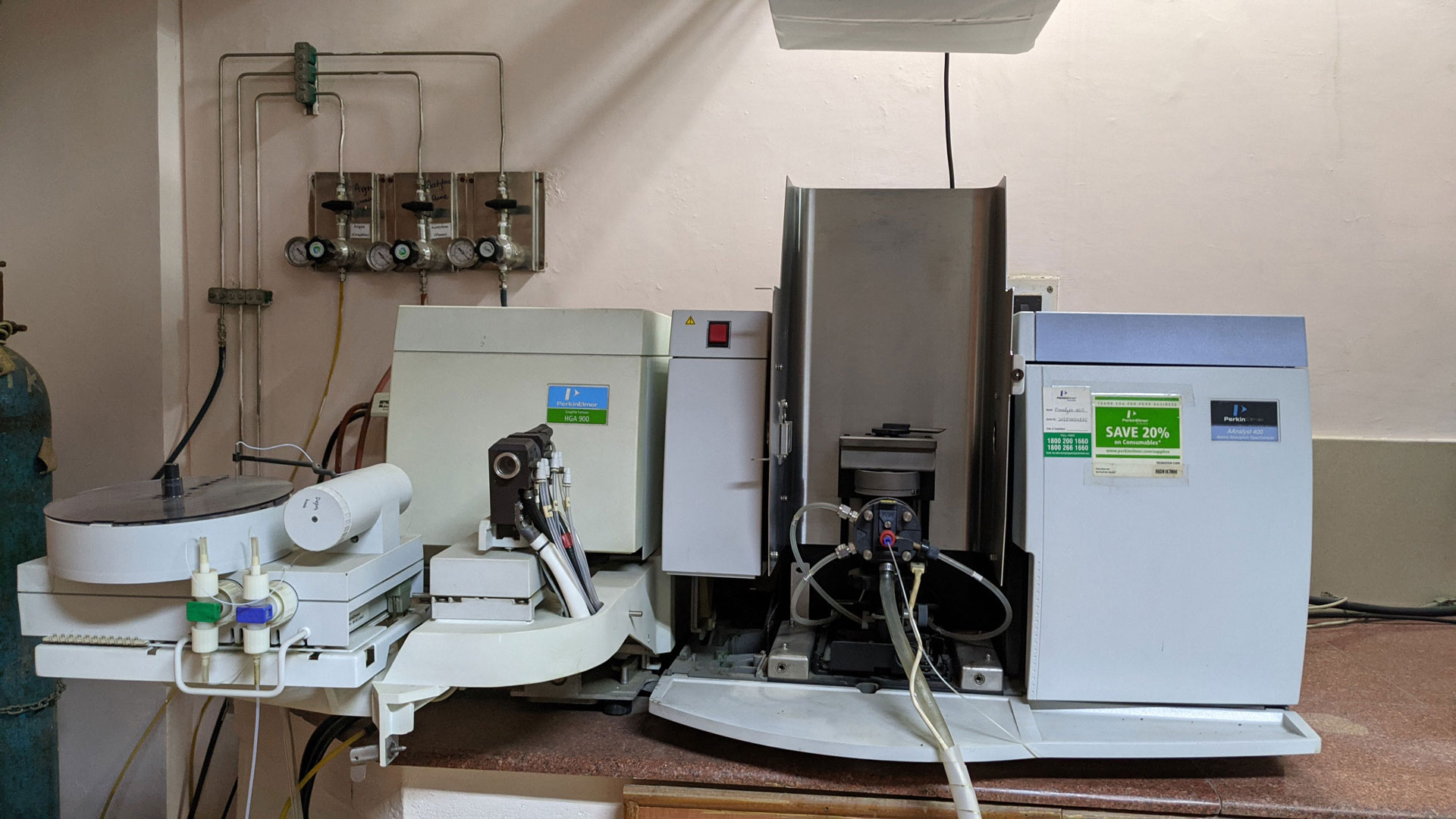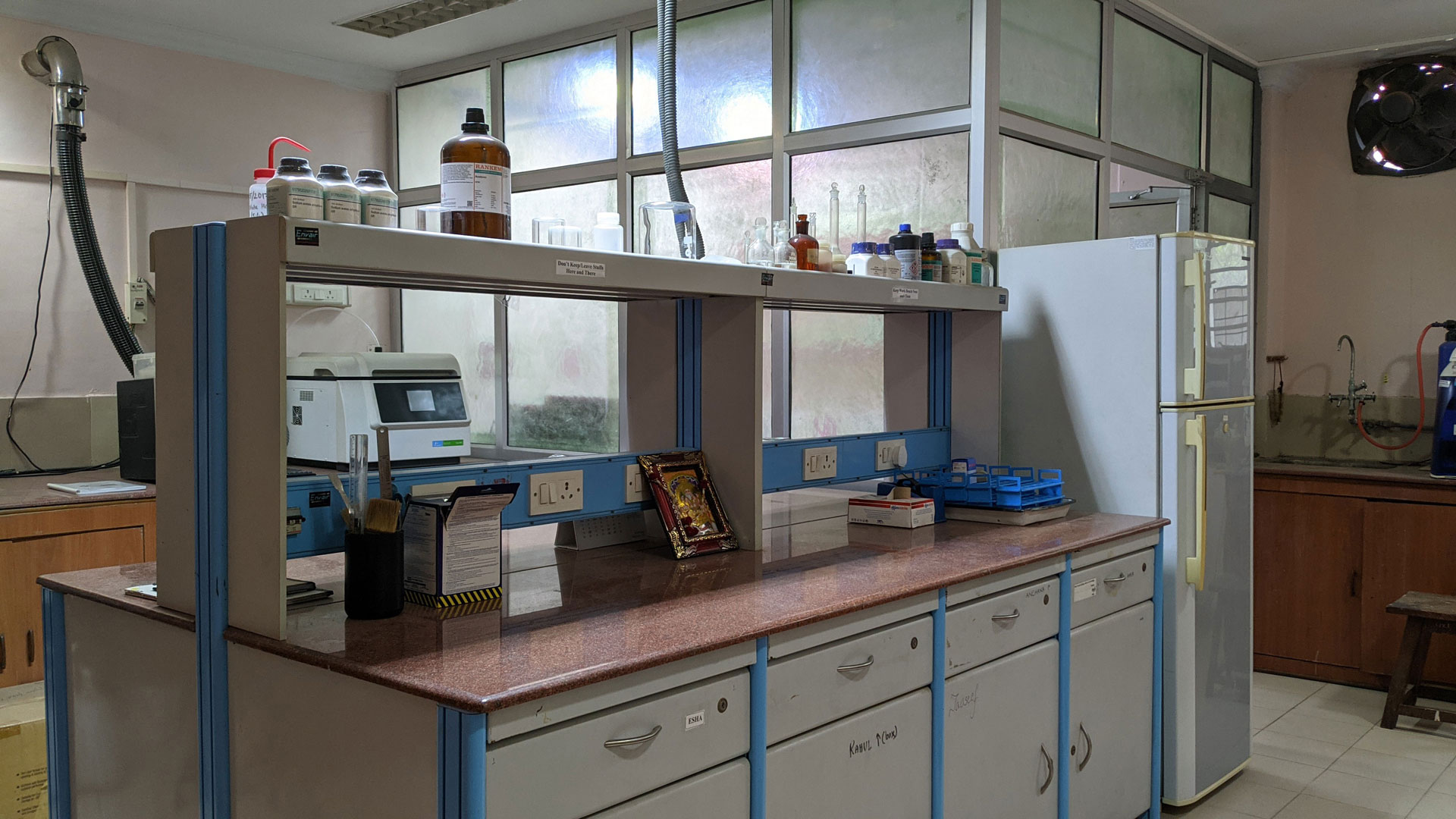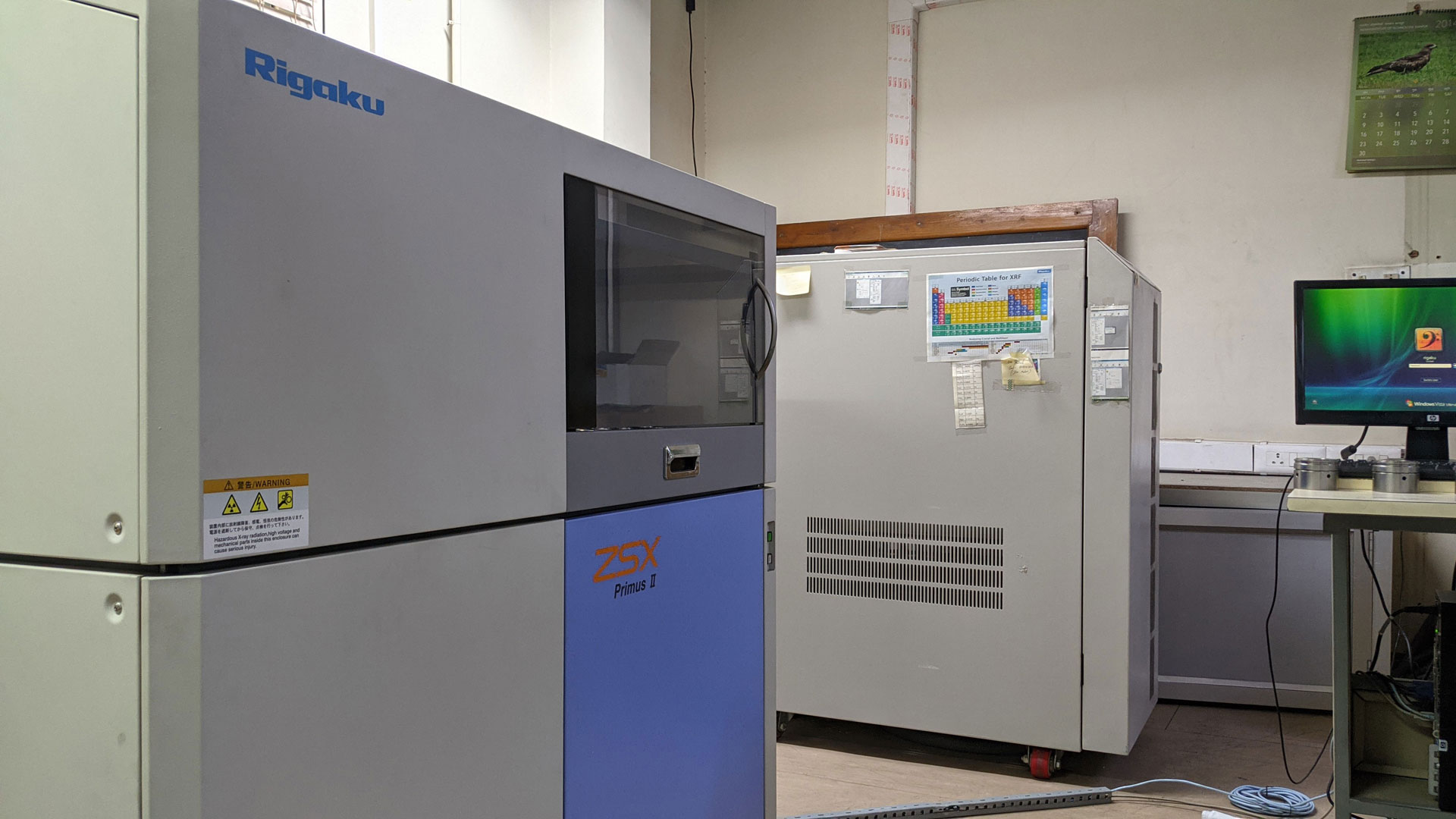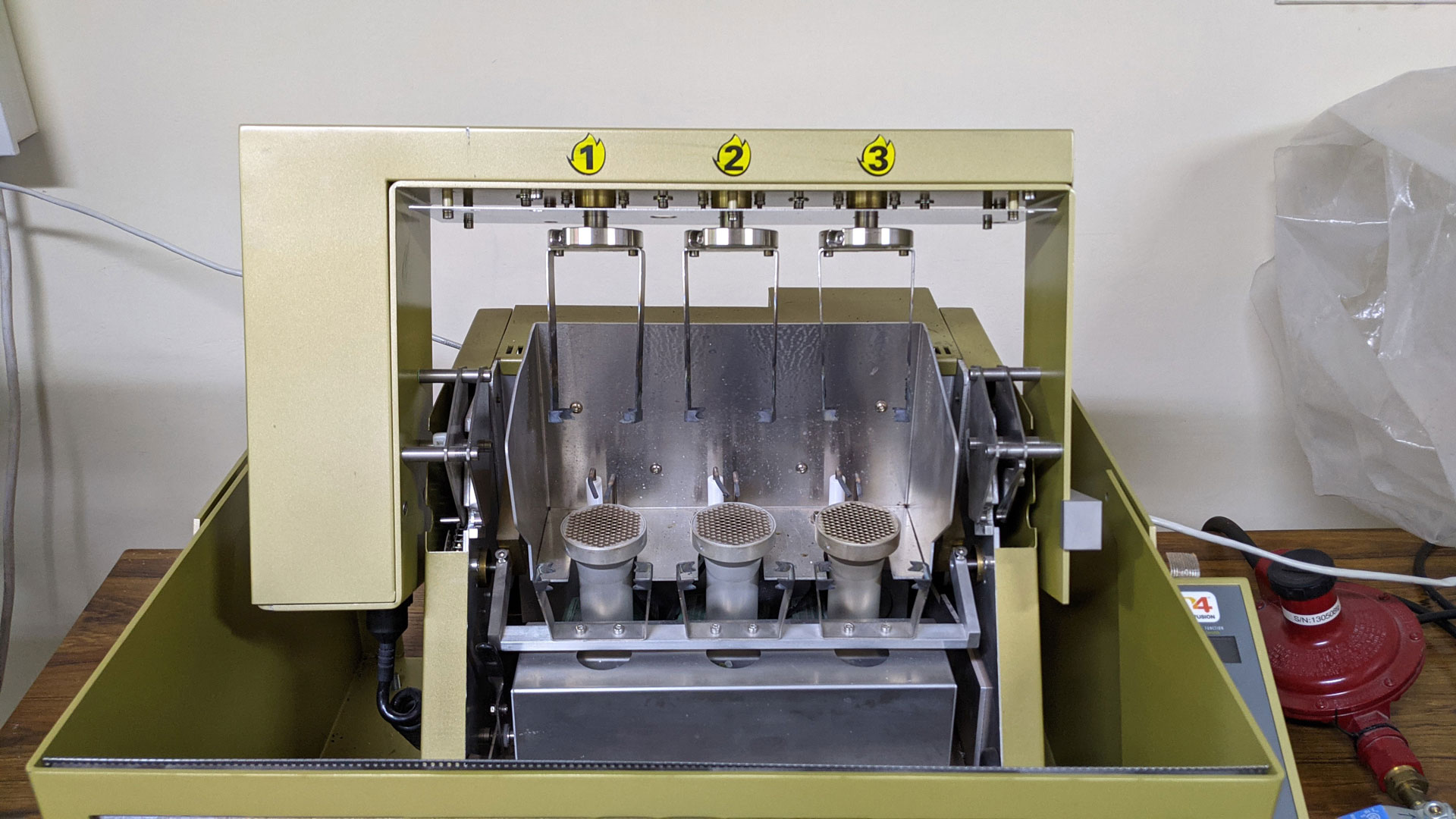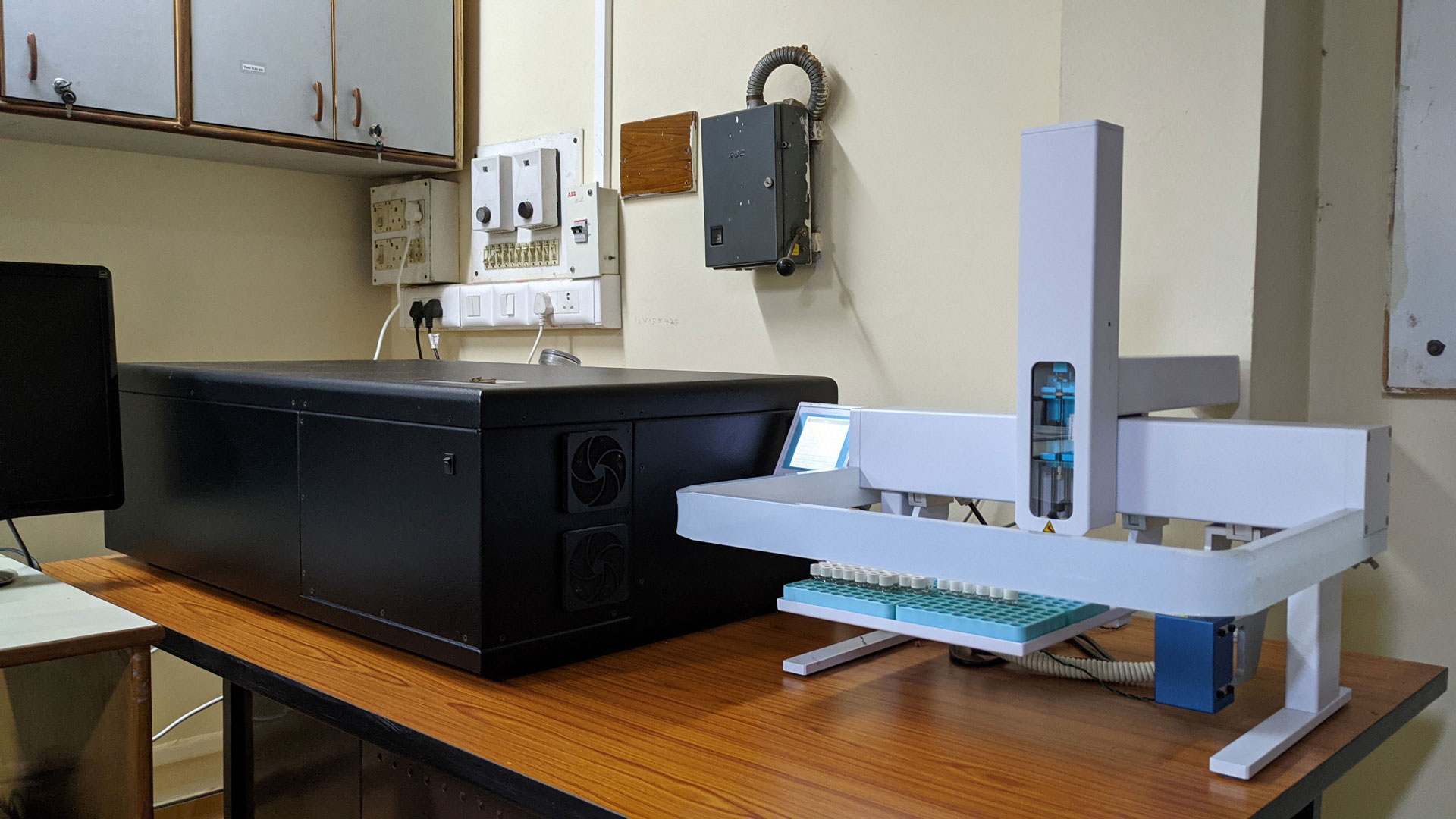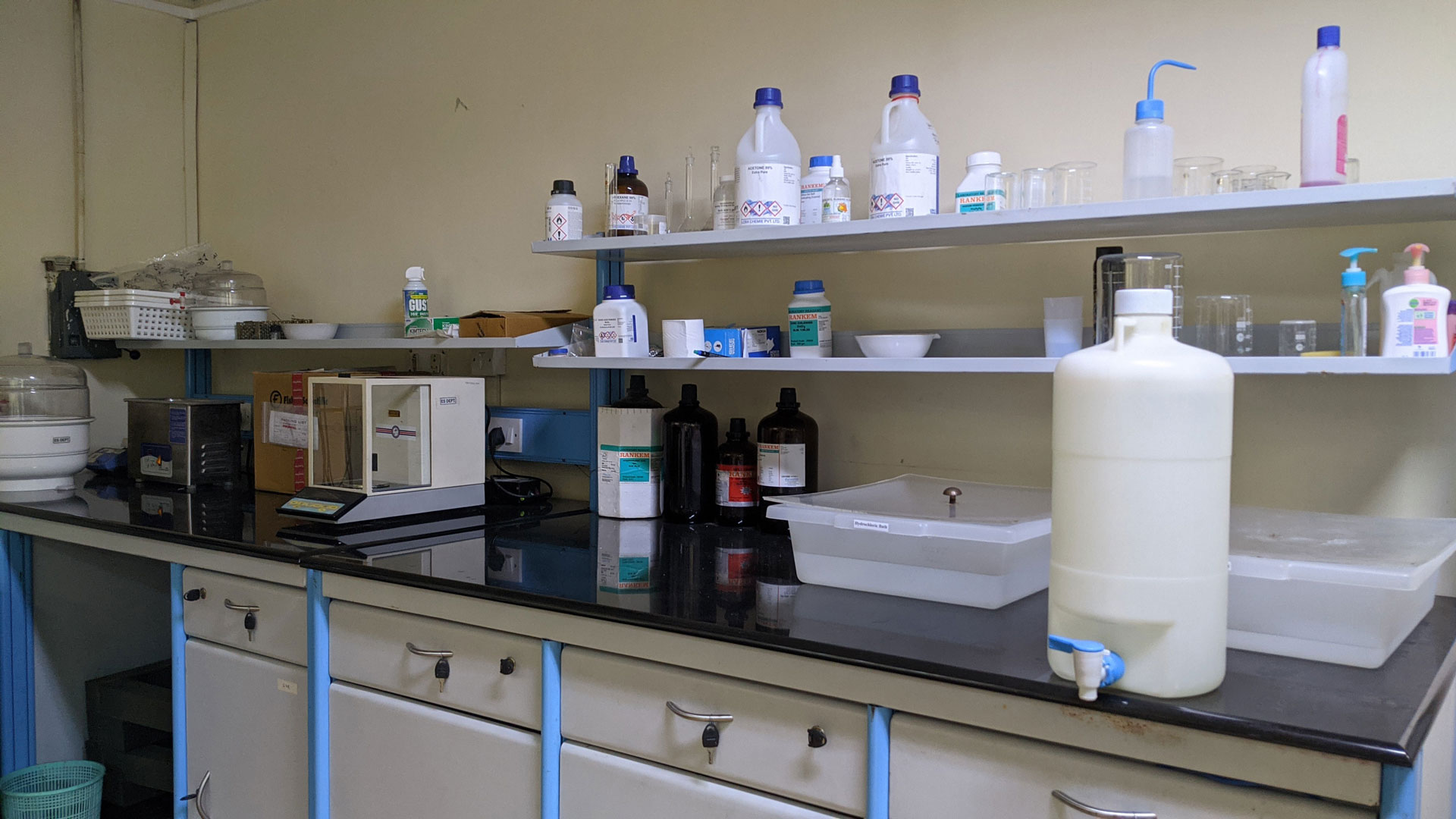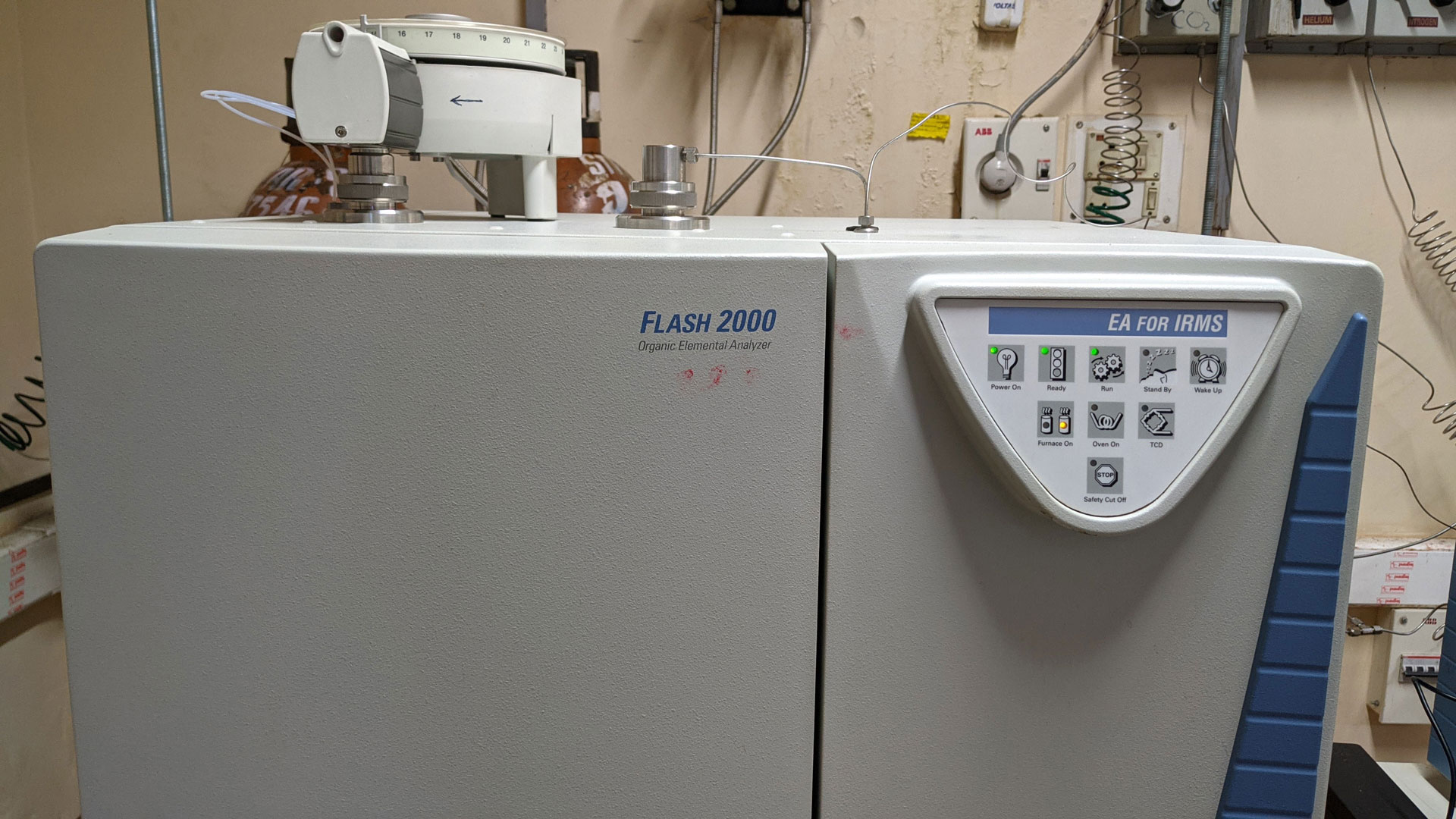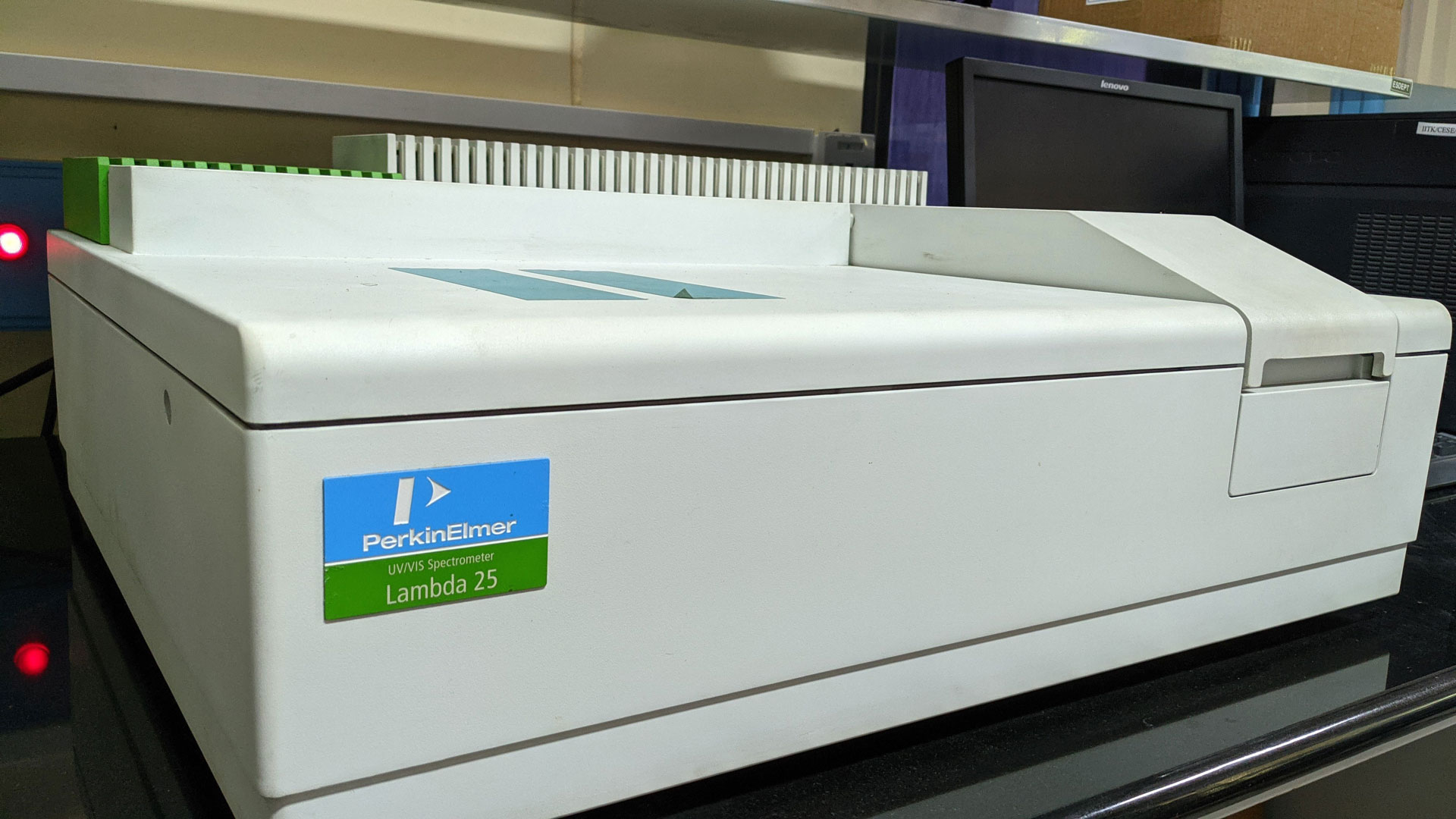About
I try to understand the physical and chemical processes in the Earth by analyzing the chemistry of its rocks. In particular, I am interested in the application of geochemical (including isotopic) proxies for both high (mantle evolution) and low-temperature (surface processes) related studies. I also work to understand the petrogenesis of Deccan Traps and Rajmahal Traps basalts. Recently, me and my students are attempting to estimate the composition of the Indian Continetal crust.

Professor
Department of Earth Sciences
- Website: https://home.iitk.ac.in/~dpaul/
- Phone: +91-512-259-6169
- Degree: PhD (Cornell University, USA)
- E-mail: dpaul@iitk.ac.in
My current research also includes reconstruction of Quaternary paleoclimate (and paleovegetation patterns) of India, with respect to the major shifts in southwest monsoon strength and precipitation, from multiple climate proxies archived in sediment records of Indus-Gangetic basin and other alluvium, and archaeological (short-lived herbivores) material. In particular, proxies such as stable oxygen and carbon isotopic composition of carbonate nodules, paleosols, sediment/soil organic matter, and clay minerals recovered from well-dated horizons are utilized to reconstruct climate history during the Quaternary.
Resume
Personal and Professional Experience
Summary
Debajyoti Paul
20+ years of teaching experience.
- WLE 201, Department of Earth Sciences, IIT Kanpur, India
- +91-512-259-6169
- dpaul@iitk.ac.in
Education
Doctor of Philosophy (Geochemistry)
2002
Cornell University, NY, USA
Master of Science (Geological Sciences)
1994
Andhra University, India
University in Visakhapatnam, Andhra Pradesh
Bachelor of Science, Geology (Hons.)
1992
Ravenshaw College
Odisha, India
Professional Experience
Professor
2018 - Present
Department of Earth Sciences, IIT Kanpur, India
Associate Professor
2014 - 2018
Department of Earth Sciences, IIT Kanpur, India
Associate Professor
2012 - 2014
Department of Civil Engineering, IIT Kanpur, India
Assistant Professor
2008 - 2012
Department of Civil Engineering, IIT Kanpur, India
Assistant Professor
2004 - 2008
Geochemistry, University of Texas at San Antonio, Texas
Alexander von Humboldt Research Fellow
2003 - 2004
Max-Planck-Institut für Chemie, Mainz, Germany
Visiting Research Fellow
2002 - 2003
Max-Planck-Institut für Chemie, Mainz, Germany
Publications
Published Articles
1996
-
Mohapatra, B.K., D. Paul, and R.K. Sahoo, 1996. REE distribution in ferromanganese oxide ores from Iron Ore Group, Western Koira Valley, Orissa, India. J. Min. Pet. Econ. Geol., 91(7), 265–274.
2001
Turcotte, D.L.,D. Paul, and W.M. White, 2001. Thorium–Uranium systematics require layered mantle convection. J. Geophys. Res., 106 (B3), 4265–4276.
2002
-
Paul, D., W.M. White, and D.L. Turcotte, 2002. Modeling the isotopic evolution of the Earth. Phil. Trans. R. Soc. Lond. A, 360, 2433–2474.
2003
-
Paul, D., W.M. White, and D.L. Turcotte, 2003. Constraints on the 232Th/238U ratio (k) of the continental crust. Geochem. Geophys. Geosyst., 4 (12), doi:10.1029/2002GC000497.
2005
-
Paul, D., W.M. White, and J. Blichert-Toft, 2005. Geochemistry of Mauritius and the origin of rejuvenescent volcanism on ocean island volcanoes. Geochem. Geophys. Geosyst., 6 (6), doi:10.1029/2004GC000883.
2006
-
Paul, D., G. Skrzypek, 2006. Flushing Time and Storage Effects on the Accuracy and Precision of Carbon and Oxygen Isotope Ratios of Sample using the Gasbench II Technique. Rapid Commun. Mass Spectrom., 20 (13), 2033–2040, doi: 10.1002/rcm.2559.
-
Skrzypek, G. and D. Paul, 2006. δ13C analyses of calcium carbonate: Comparison between the GasBench and Elemental Analyzer Techniques. Rapid Commun. Mass Spectrom., 20, 2915–2920, DOI: 10.1002/rcm.2688.
2007
-
Paul, D., G. Skrzypek, 2007. Assessment of carbonate-phosphoric acid analytical technique performed using GasBench II in continuous flow isotope ratio mass spectrometry. Int. J. Mass Spectrom., 262(3), 180–186.
-
Paul, D., V. S. Kamenetsky, A. W. Hofmann, and A. Stracke, 2007. Compositional Diversity among Primitive Lavas of Mauritius, Indian Ocean: Implications for Mantle Sources. J. Volcanol. Geotherm. Res., 164, 76–94.
-
Paul, D., G. Skrzypek, and F. Istvan, 2007. Normalization of measured stable isotopic compositions to isotope reference scales - a review. Rapid Commun. Mass Spectrom., 21, 3006–3014, DOI: 10.1002/rcm.3185.
2008
-
Jezierski A., G. Skrzypek, P. Jezierski, D. Paul, M.O. Jedrysek, 2008. Electron paramagnetic resonance (EPR) and stable isotope records of paleoenvironmental conditions during peat formation. Spectrochimica Acta Part A, 69, 1311-1316.
-
Menezes, L. A., D. Paul, W.P. Silveira, L. R. Bastos Leal, S.C.P. Cruz, and J.P. Santos, 2008. Geochemistry and origin of the tholeiitic mafic metavolcanic rocks from the Riacho de Santana Greenstone belt, Bahia, Brazil. Revista Brasileira de Geociências, 38(3): 476-487.
-
Skrzypek, G., D. Paul, and B. Wojtun, 2008. Stable isotope composition of plants and peat from Arctic mire and geothermal area in Iceland. Polish Polar Research Journal, 29 (4), 365-376.
2010
-
Engell, Z., G. Skrzypek, D. Paul, W. Drzewicki, and D. Nývlt, 2010. Sediment lithology and stable isotope composition of organic matter in a core from a circque in the Krkonoše Mountains, Czech Republic. Journal of Paleolimnology, 43, 609-624.
-
Skrzypek, G., R. Sadler, and D. Paul, 2010. Error propagation in normalization of stable isotope data: a Monte Carlo analysis. Rapid Commun. Mass Spectrom., 24, 2697–2705, DOI: 10.1002/rcm.4684.
2011
-
Munoz C., R. Mauldin, D. Paul, and L. Kemp, 2011. Monitoring paleovegetation shifts through stable carbon isotope variability in archaeologically recovered leporids. Journal of the Texas Academy of Sciences, v. 63.
-
Moore, J. C., W.M. White, D. Paul, R.A. Duncan, W. Abouchami, and S.J.G. Galer, 2011. Evolution of Shield-building and Rejuvenescent Volcanism of Mauritius. Journal of Volcanology and Geothermal Research, 207, 47–66.
-
Chalapati Rao N.V, D. Paul, and A. Saikia, 2011. National Workshop on Critical Appraisal of Plume and Alternate Hypotheses into the Origin of Melting Anomalies: Perspectives and Prospects of Research in India. Journal of Geological Society of India, v. 78, JULY 2011.
-
Skrzypek, G., R. Sadler, D. Paul and I. Foriz, 2011. Normalization Methods and Selection Strategies for Reference Materials in Stable Isotope Analyses Review. International Atomic Energy agency document
2012
-
Paul D., Swati, 2012. Global Surface Heat Flow and its implications on mantle structure. Journal of Applied Geochemistry, 14(4), 509-527.
2013
-
Paul D., and R. Mauldin, 2013. Implications for Late Holocene climate from stable carbon and oxygen isotopic variability in soil and land-snail shells from archaeological site 41KM69 in Texas, USA. Quaternary International, 308-309, 242-252.
-
Skrzypek, G., D. Paul, and B Wojtun, 2013. The altitudinal climatic effect on the stable isotope compositions of Agave and Opuntia in arid environments - a case study at the Big Bend National Park, Texas, USA. Journal of Arid Environments, 92, 102-112.
-
Sensarma S., D. Paul, N V Chalapati Rao, 2013. Large Igneous Provinces: Global Perspectives and Research Prospects in India. Current Science, 105 (2), 182-192.
2014
-
Ghosh, S., T. Gupta, N. Rastogi, A. Gaur, A. Misra, S.N. Tripathi, D. Paul, V. Tare, O. Prakash, D. Bhattu, A.K. Dwivedi, D. Kaul, R. Dalai, S. K. Mishra, 2014. Chemical Characterization of Summertime Dust Events at Kanpur: Insight into the Sources and Level of Mixing with Anthropogenic Emissions. Aerosol and Air Quality Research, x: 1–13, xxxx, doi: 10.4209/aaqr.2013.07.0240.
-
Smith S., R Mauldin, C. M. Munoz, R. Hard, D. Paul, G. Skrzypek, P. Villanueva, and L. Kemp., 2014. Exploring the use of stable carbon isotope ratiosin short-lived leporids for local paleoecological reconstruction. In: RH Tykot (ed.), Proceedings of the 38th International Symposium on Archaeometry – May 10th-14th 2010, Tampa, Florida. Open Journal of Archaeometry, 2:5306.
-
Misra, A., A. Gaur; D. Bhattu, S. Ghosh, A. Dwivedi, R. Dalai, D. Paul, T. Gupta, V. Tare, S. Mishra, S. Singh, S. Tripathi, 2014. An Overview of the Physico-Chemical Characteristics of Dust over the Indo-Gangetic Basin. Atmospheric Environment, 97, 386–396.
2015
-
Paul,D., B.C. Choudhary, T. Gupta, M. T. Jose, 2015. Spatial distribution and the extent of heavy metal and hexavalent chromium pollution in agricultural soils from Jajmau, India. Environmental Earth Science, 73:3565-3577. DOI: 10.1007/s12665-014-3642-6.
2016
-
Sen, I., M. Bizimis, S.N. Tripathi, D. Paul, 2016. Lead isotopic fingerprinting of aerosols to characterize the sources of atmospheric lead in an industrial city of India. Atmospheric Environment, 129, 7-33.
-
Singh, A., D. Paul, R. Sinha, K.J. Thomsen, S. Gupta, 2016. Geochemistry of buried river sediments from Ghaggar Plains, NW India: Multi-proxy records of variations in provenance, paleoclimate, and paleovegetation patterns in the Late Quaternary. Palaeogeography, Palaeoclimatology, Palaeoecology, 449, 85-100.
-
Seema, K., D. Paul, A. Stracke, 2016. Open system models of isotopic evolution in Earth's silicate reservoirs: implications for crustal growth and mantle heterogeneity. Geochimica et Cosmochimica Acta, 195, 142-157.
-
Singh, A., D. Paul, R. Sinha, K.J. Thomsen, S. Gupta, 2016. Reply to the comment on "Geochemistry of buried river sediments from Ghaggar Plains, NW India: Multi-proxy records of variations in provenance, paleoclimate, and paleovegetation patterns in the Late Quaternary" by Singh et al. (2016). Palaeogeography, Palaeoclimatology, Palaeoecology, 455, 68-70.
2017
-
Choudhary, B.C., D. Paul, T. Gupta, S.R. Tetgure, V.J. Garole, A.U. Borse, D. J. Garole, 2017. Photocatalytic reduction of organic pollutant under visible light by green route synthesized gold nanoparticles. J. of Environmental Sciences, 55, 236-246.
-
Sensarma S., H. Singh, R. S. Rana, D. Paul, A. Sahni, 2017. Nature and Composition of interbedded marine basaltic pumice in the ~52-50 Ma Vastan lignite sequence, western India: Implication for early Eocene MORB volcanism offshore Arabian Sea. J. Earth System Science, 126:17. DOI: 10.1007/s12040-017-0806-2
-
Choudhary, B.C., D. Paul, A.U. Borse, D. J. Garole, 2017. Recovery of palladium from secondary waste using soluble tannins cross-linked Lagerstroemia speciosa leaves powder. J. of Chemical Technology & Biotechnology, DOI 10.1002/jctb.5163.
-
Choudhary, B.C., D. Paul, A. Singh, T. Gupta, 2017. Removal of hexavalent chromium upon interaction with biochar under acidic conditions: mechanistic insights and application. Environmental Science and Pollution Research, 24:16786–16797, DOI: 10.1007/s11356-017-9322-9.
-
Mishra S. K., N. Saha, S. Singh, C. Sharma, M. V. S. N. Prasad, S. Gautam, A. Misra, A. Gaur, D. Bhattu, S. Ghosh, A. Dwivedi, R. Dalai, D. Paul, T. Gupta, S.N. Tripathi, R.K. Kotnala, 2017. Morphology, Mineralogy and Mixing of Individual Atmospheric Particles over Kanpur (IGP): Relevance of Homogeneous Equivalent Sphere Approximation in Radiative Models. Journal of Metrology Society of India, DOI: 10.1007/s12647-017-0215-7.
-
Singh, G., D. Paul, T. Gupta, P. Rajput, A.K. Singh, 2017. Stable carbon isotope analysis of wintertime aerosols from Kanpur. Published in International Conference on Sustainable Energy and Environmental Challenges (SEEC-2017).
-
Singh, A., K.J. Thomsen, R. Sinha, J-P. Buylaert, A. Carter, D.F. Mark, P.J. Mason, A.L. Densmore, A.S. Murray, M. Jain, D. Paul, S. Gupta, 2017. Counter-intuitive influence of Himalayan river morphodynamics on Indus Civilisation urban settlements. Nature Communications, 8: 1617, DOI:10.1038/s41467-017-01643-9
2018
-
Chandra, J., D. Paul, S. Viladkar, S. Sensarma, 2018. Origin of the Amba Dongar Carbonatite Complex, India and its possible linkage with the Deccan Large Igneous Province. In SENSARMA, S. & STOREY, B. C. (eds) Large Igneous Provinces from Gondwana and Adjacent Regions. Geological Society, London, Special Publications, 463, 137-169, DOI: https://doi.org/10.1144/SP463.3.
-
Sensarma S., A. Martin, D. Paul, A. Patra, A.K. Madhesiya, G. Sarkar, 2018. Reddening of ~2.5 Ga granitoid by high‐temperature fluid linked to mafic dyke swarm in the Bundelkhand Craton, north central India. Geological Journal, 53, 1338-1353, DOI: 10.1002/gj.2960.
-
Singh, G., D. Paul, P. Rajput, T. Gupta, 2018. Stable Carbon Isotope and Bulk Composition of Wintertime Aerosols from Kanpur. In: Gupta T., Agarwal A., Agarwal R., Labhsetwar N. (eds) Environmental Contaminants. Energy, Environment, and Sustainability, 209-220. Springer, Singapore, DOI: 10.1007/978-981-10-7332-8
-
Awasthi, N., E. Ray, D. Paul, 2018. Sr and Nd isotope compositions of alluvial sediments from the Ganga Basin and their use as potential proxies for source identification and apportionment. Chemical Geology, 476, 327-339, DOI: 10.1016/j.chemgeo.2017.11.029.
-
Choudhary, B.C., D. Paul, A.U. Borse, D. J. Garole, 2018. Surface functionalized biomass for adsorption and recovery of gold from electronic scrap and refinery wastewater. Journal of Separation and Purification Technology, 195, 260-270.
-
Garole, D. J., B.C. Choudhary, D. Paul, A.U. Borse, 2018. Sorption and recovery of platinum from simulated spent catalyst solution and refinery using chemically modified biomass as a novel sorbent. Environmental Science and Pollution Research, DOI: 10.1007/s11356-018-1351-5.
-
Khan, I., M. Amir, D. Paul, P. Srivastava, 2018. Late Holocene aridification recorded in the stable carbon and nitrogen isotope composition of soils from Nainital, Lesser Himalaya. Quaternary International, 467, 195-203, DOI: 10.1016/j.quaint.2018.01.044
-
Choudhary, B.C., D. Paul, 2018. Isotherms, kinetics and thermodynamics of hexavalent chromium removal using biochar. Journal of Environmental Chemical Engineering, 6, 2335-2343.
-
Singh, G., P. Rajput, D. Paul, T. Gupta, 2018. ; Wintertime study on bulk composition and stable carbon isotope analysis of ambient aerosols from North India. Journal of Aerosol Science, 126, 231-241 DOI: 10.1016/j.jaerosci.2018.09.010.
-
Amir, M., D. Paul, A. Singh, S. Gupta, F. Chabaux, M. Granet, S. Balakrishnan, 2018. Link between climate and catchment erosion in the Himalaya during late Quaternary. Chemical Geology, 501, 68:76, DOI: /10.1016/j.chemgeo.2018.10.006.
2019
-
Singh G.K., P. Rajeev, D. Paul, T. Gupta, 2019. Atmospheric Emissions from Thermal (Coal-Fired) Power Plants and Associated Environmental Impacts. In: Agarwal R., Agarwal A., Gupta T., Sharma N. (eds) Pollutants from Energy Sources. Energy, Environment, and Sustainability. Springer, Singapore.
-
Amir, M., D. Paul, R.N. Samal, 2019. Sources of organic matter in Chilika lagoon, India inferred from stable C and N isotopic compositions of particulates and sediments.Journal of Marine Systems, 194, 81-90.
-
Gupta, S., S. H. Karumanchi, S. K. Dash, . Adla, S. Tripathi, R. Sinha, D. Paul, and I. S. Sen, 2019. Monitoring ecosystem health in India's food basket, Eos, 100, https://doi.org/10.1029/2019EO117683.
-
Chandra, J., D. Paul, A. Stracke, F. Chabaux, M. Granet, 2019. The origin of carbonatites within the Deccan Large Igneous province. Journal of Petrology, 60(6), 1119-1134, DOI: 10.1093/petrology/egz026.
-
Patnaik, R., N. Singh, D. Paul, R. Sukumar, 2019. Dietary and habitat shifts in relation to climate of Neogene-Quaternary proboscideans and associated mammals of the Indian subcontinent. Quaternary Science Reviews, 224, 105968, DOI: 10.1016/j.quascirev.2019.105968.
-
Seema, K., D. Paul, A. Stracke, 2019. Constraints on Archean crust formation from open system models of Earth evolution. Chemical Geology, 530, 119307, DOI: 10.1016/j.chemgeo.2019.119307
-
Malik J.N.M., F, Johnson, A, Khan, S, Sahoo, R, Irshad, D. Paul, S. Arora, P. K. Baghel, S. Chopra, 2019. Tsunami records of the last 8000 years in the Andaman Island, India, from mega and large earthquakes: Insights on recurrence interval. Scientific Reports, 9:18463, DOI: 10.1038/s41598-019-54750-6
2020
-
Sinha, S.K., A. Kumar, A. Tyagi, K. Venakatesh, D. Paul, N. K. Singh, P. K. Mandal, 2020. Root architecture traits variation and nitrate-influx responses in diverse wheat genotypes under different external nitrogen concentrations. Plant Physiology and Biochemistry, 148, 246-259.
-
Singh G.K., V. Choudhary, T. Gupta, D. Paul, 2020.Investigation of size distribution and mass characteristics of ambient aerosols emitted from combustion of paddy-residue sources during post-monsoon in Northern India. Atmospheric Pollution Research, 11, 170 - 178, DOI: /10.1016/j.apr.2019.10.003.
-
Paul, D., J. Chandra, M. Halder, 2020. Proterozoic Alkaline rocks and carbonatites of Peninsular India: A review. Episodes, 43(1), 249-277.
-
Kumar, A., A. Singh, D. Paul, A. Kumar, 2020. Evaluation of hydrocarbon potential with insight into climate and environment present during deposition of the Sonari lignite, Barmer Basin, Rajasthan. Accepted in Energy and Climate Change.
-
Sensarma, S., A. Martin, D. Paul, A. Madhesiya, G. Sarkar, 2020. Evolution of a crustal-scale silicic to intermediate tectono-magmatic system: The c. 2600-2300 Ma Bundelkhand granitoid, India. Precambrian Research, DOI: 10.1016/j.precamres.2020.105951.
-
Singh G.K., P. Rajeev, D. Paul, T. Gupta, 2020. Chemical characterization and stable nitrogen isotope composition of nitrogenous component of ambient aerosols from Kanpur in the Indo-Gangetic Plains. Science of the Total Environment, DOI: 10.1016/j.scitotenv.2020.143032.
2021
-
Amir, M., D. Paul, J.N. Malik, 2021. Geochemistry of Holocene sediments from Chilika Lagoon, India: inferences on the sources of organic matter and variability of the Indian summer monsoon. Quaternary International, 599-600, 148-157. DOI: 10.1016/j.quaint.2020.08.050.
-
Halder M., D. Paul, S. Sensarma, 2021. Rhyolites in continental mafic Large Igneous Provinces: petrology, geochemistry and petrogenesis. Geoscience Frontiers, 12, 53-80. DOI:/10.1016/j.gsf.2020.06.011.
-
Choudhary V., G.K. Singh, T. Gupta, D. Paul, 2021. Absorption and radiative characteristics of brown carbon aerosols during crop residue burning in the source region of Indo-Gangetic Plain. Atmospheric Research, 249, 105285. DOI: 10.1016/j.atmosres.2020.105285.
-
Singh G.K., V. Choudhary, P. Rajeev, D. Paul, T. Gupta, 2021. Understanding the origin of carbonaceous aerosols during periods of extensive biomass burning in Northern India. Environmental Pollution, 270, 116082. DOI: https://doi.org/10.1016/j.envpol.2020.116082.
-
Sensarma, S., A. Martin, D. Paul, A. Madhesiya, G. Sarkar, 2021. Evolution of a crustal-scale silicic to intermediate tectono-magmatic system: The c. 2600-2300 Ma Bundelkhand granitoid, India. Precambrian Research, 352, 105951. DOI: https://doi.org/10.1016/j.precamres.2020.105951.
-
Shah, R.A., H. Achyuthan, A.M. Lone, M.K. Jaiswal, D. Paul, 2021. Constraining the timing and deposition pattern of loess-palaeosol sequences in Kashmir Valley, Western Himalaya: Implications to paleoenvironment studies. Aeolian Research, 49, 100660. DOI: https://doi.org/10.1016/j.aeolia.2020.100660.
-
Pandey, O.P., K. Mezger, D. Upadhyay, D. Paul, A. K. Singh, U. Söderlund, A. Gumsley, 2021. Major-trace element and Sr-Nd isotope compositions of mafic dykes of the Singhbhum Craton: insights into evolution of the lithospheric mantle. Lithos, 382-383, 105959. DOI: https://doi.org/10.1016/j.lithos.2020.105959.
-
Białas, N., O. Prymak, N. P. Singh, D. Paul, R. Patnaik, M. Epple, 2021. Teeth of past and present elephants: Microstructure and composition of enamel in fossilized proboscidean molars and implications for diagenesis. Geochemistry, Geophysics, Geosystems, 22, e2020GC009557. DOI: https://doi.org/10.1029/2020GC009557.
-
Ray E., D. Paul, 2021. Major and trace element characteristics of Indian shale: implications for provenance, weathering, and depositional environment. ACS Earth Space Chemistry, 5, 1114-1129. DOI: https://doi.org/10.1021/acsearthspacechem.1c00030.
-
Kumar, A., A. K. Singh, D. Paul, A. Kumar, 2021. Paleoenvironmental, paleovegetational, and paleoclimatic changes during Paleogene lignite formation in Rajasthan, India. Arabian Journal of Geosciences, 14: 2350. DOI: https://doi.org/10.1007/s12517-021-08638-3.
2022
-
Singh G.K., P. Rajeev, D. Paul, T. Gupta, 2022. Insights into sources and atmospheric processing at two polluted urban locations in the Indo-Gangetic plains from stable carbon and nitrogen isotope ratios and polycyclic aromatic hydrocarbons in ambient PM2.5. Atmospheric Environment, 271, 118904. DOI: https://doi.org/10.1016/j.atmosenv.2021.118904.
-
Md. Tauseef, Ray E., D. Paul, J.N. Malik, 2022. Mineralogical, geochemical, and magnetic susceptibility variations in the loess-paleosol sequence from Pattan, Kashmir Valley, India record an enhanced Indian summer monsoon around 35 ka. Quaternary International, 616, 55-66. DOI: https://doi.org/10.1016/j.quaint.2021.12.014.
-
Kulkarni, K.L., A. Tripathi, A. Varshney, J. Chandra, S. Kumar, S. Sangal, D. Paul, K. Mondal, 2022. Electron Probe Micro-Analyser: An Equipment for Accurate and Precise Micro-Composition Analysis. Electron Microscopy in Science and Engineering, 71-93, Springer, Singapore.
-
Chandra, J., D. Paul, A. Uniyal, 2022. Petrography and geochemistry of carbonatite breccia from Amba Dongar carbonatite complex, Gujarat in the Deccan Large Igneous Province suggest mantle origin. Accepted in Journal of Earth System Science.
Pandey, O.P., D. Paul, 2022. Secular evolution of the subcontinental lithospheric mantle beneath Indian cratons: Insights from the Precambrian mafic intrusions. Lithos, 422-423, 106729. DOI: https:// https://doi.org/10.1016/j.lithos.2022.106729.
Qadri, A.M., G.K. Singh, D. Paul*, T. Gupta, S. Rabha, N. Islam, B.K. Saikia, 2022. Variabilities of δ13C and carbonaceous components in ambient PM2.5 in Northeast India: Insights into sources and atmospheric processes. Environmental Research, 214, 113801. DOI: https://doi.org/10.1016/j.envres.2022.113801.
Yadav, K., A. Bhardwaj, D. Paul, T. Gupta, D. Shukla, S. V. Laxmi Prasad, K. S. Lokesh, 2022. Tracing the predominant sources of carbon in PM2.5 using δ13C values together with OC/EC and select inorganic ions over two COALESCE network locations. Chemosphere, 308, 136420. DOI: https://doi.org/10.1016/j.chemosphere.2022.136420.
Seema, K., A. Stracke, D. Paul, 2022. Open-system 182W-142Nd isotope evolution of the early Earth. Chemical Geology, 611, 122204. https://doi.org/10.1016/j.chemgeo.2022.121104.
2023
Halder M., D. Paul, S. Yang, 2023. Origin of silicic rocks of the Deccan Traps continental flood basalt province: Inferences from field observations, petrography, and geochemistry. Geochemistry, 83, 125958. DOI: https://doi.org/10.1016/j.chemer.2023.125958.
Halder M., D. Paul, A. Stracke, 2023. Petrogenesis of the Girnar Volcano-plutonic Complex in the Deccan Traps Province, India. Journal of Petrology, 64, 1-25. DOI: https://doi.org/10.1093/petrology/egad013.
Ray E., D. Paul, R. Bhutani, R. Chakrabarti, S. Yang, 2023. Sm-Nd isotope systematics of Indian shales constrain the growth of continental crust: Implication for supercontinent cycle and mantle plume activity. Lithos, 442-443, 107051. DOI: https://doi.org/10.1016/j.lithos.2023.107051.
Singh G.K., A.M. Qadri, D. Paul, T. Gupta, S. Mukherjee, A. Chatterjee, 2023. Investigation of sources and atmospheric transformation of carbonaceous aerosols from Shyamnagar, eastern Indo-Gangetic Plains: Insights from δ13C and carbon fractions. Chemosphere. DOI: https://doi.org/10.1016/j.chemosphere.2023.138422.
Satuluri, S., D. Paul, S.K. Sinha, 2023. Nitrogen assimilation and fractionation dynamics in wheat genotypes grown in different mediums. Journal of Plant Growth Regulation. https://doi.org/10.1007/s00344-023-11020-0.
People
List of current students/staff
Ph.D. (On-going)
ANCHANA P
PMRF Fellow
2021
“Climate Interpretation from Peat-based geochemical proxies”
- Roll Number: 21223264
- E-mail: anchanap20@iitk.ac.in
M.Tech. (On-going)
Bikash Kumar Mallick
2022 - 2024 Batch
"Assessment of Lithium reserves in India"
- Roll Number: 22123006
- E-mail: bikashkr22@iitk.ac.in
Lab Members
Ph.D. (Completed)
Ajit Singh
2014
Subsurface stratigraphy, sediment geochemistry, and paleoclimatic reconstruction in Ghaggar plains in NW India: linkage of landscape evolution and cultural heritage.
R. Sinha & D. Paul
Jyoti Chandra
2017
The role of mantle plume in the generation of carbonatites and associated alkaline silicate rocks from Amba Dongar, Gujarat, India.
D. Paul
Mohd Amir
2020
Geochemistry of sediments from Chilika lagoon and northwest Indo-Gangetic alluvial plain: reconstruction of paleoclimate and catchment erosion variabilities in the late Quaternary.
D. Paul
Seema Kumari
2021
Open-system isotopic evolution models of Earth: Implications for core formation, late accretion, and crust-mantle differentiation.
D. Paul
Gyanesh Kumar Singh
2021
Investigation of ambient aerosol load, size distribution, and physico-chemical transformation using bulk chemical characterization and stable isotopic (C and N) compositions.
Tarun Gupta & D. Paul
Mahesh Halder
2022
Origin of silicic magma in the Deccan Large Igneous Province.
D. Paul
Esha Ray
2023
Chemical composition of clastic sediments and sedimentary rocks from India: Implication for provenance, weathering, and growth of the Indian continental crust.
D. Paul
M.Tech. (Completed)
Srijani Das
2021 - 2023
Evaluation of trace and heavy metals contamination and geochemical partitioning in surface sediments of Muttukadu Estuary, Tamil Nadu.
Yashodhara
2019 - 2021
Petrography and geochemistry of rocks from the deccan province, Dewas, Madhya Pradesh, India.
Md Tauseef
2018 - 2020
Geochemistry of a loess-paleosol sequence from Kashmir Valley, India: implication for late Pleistocene climate.
Puja Dey
2017 - 2019
Textural and Compositional variability in Basalt within Deccan Traps borehole in Koyna region, Maharashtra.
Rahul Singh
2016 - 2018
Physicochemical characteristics of soils from the Critical Zone Observatory in the Ganga Basin.
Tapas Kumar Nahak
2016 - 2018
Origin of Rajmahal volcanic province and its link to the Kerguelen mantle plume.
Gaurav Sharma
2014 - 2016
Characterizing response of laser scanners for some common archaeological materials.(Co-advisor: B. Lohani)
Aqib Jamal Ansari
2014 - 2016
Presence of recycled oceanic crust in Amba Dongar carbonatites: constraints from Re-Os isotope systematics.
Abhinav Uniyal
2014 - 2016
Stable carbon and oxygen isotope composition of carbonatites from Amba Dongar, Gujarat, India.
Gyanesh Kumar Singh
2013 - 2015
Stable carbon isotope composition of Black carbon (BC) in PM2.5 aerosol particles from Kanpur, India: An attempt for source identification.
Shubham Gupta
2013 - 2015
Optimization of WD-XRF analytical technique to measure elemental abundance in PM2.5 dust collected on quartz-fibre filter.
Manish Kumar Yadav
2012 - 2014
Sub-surface stratigraphy and sediment geochemistry of Kosi megafan, India
Seema Kumari
2012 - 2014
Modeling Geochemical Evolution of Earth's Terrestrial Reservoirs.
Sharath M. N.
2012 - 2014
Experimental Studies on Aggregate Durability. (Co-advisor: A. Das)
Soumyajit Koley
2012 - 2014
Cost-benefit analysis of arsenic remediation and disposal practices in North 24 Parganas, West Bengal, India.
Mohd Amir
2011 - 2013
Inferences on Sediment Provenance and Paleoclimate using Major, Trace and Sr-Nd Isotopic Compositional Variations in Alluvial Sediments from Sirhind, Punjab, India.
Imran Khan
2010 - 2012
Micromorphology and Geochemistry of modern Alfisol from Nainital, India: Paleoclimate climate implication.
Priya Kundley
2010 - 2012
Uptake of chromium and arsenic from waste water by duckweed. (Co-advisor: S. Guha)
Nikhil Upadhye
2013, Dual Degree
Modeling crustal evolution and heat flow using forward transport models.
Swati
2012, Dual Degree
Inferences on layering and structure of earth's mantle from global surface heat flow and geochemical constraints.
Melvin Thomas Joseph
2012, Dual Degree
Assessment of soil characteristics and metal contamination in jajmau area, Kanpur, India.
Manu Rastogi
2012, Dual Degree
Geochemistry and weathering history of buried river sediments from Ghaggar plains, NW India.
Postdoctoral Research Fellows
Dr. Rohit Kumar Giri
2022 - 2024
Banaras Hindu University, Varanasi
Dr. Om Praksh Pandey
2019 - 2021
University of Bern, Switzerland
Dr. Neeraj Awasthi
2015 - 2018
Physical Research Laboratory,Ahmedabad, Gujarat, India
Dr. Angela Beatriz Leal
2006 - 2007
Visiting Associate Professor, Institute of Geosciences, University Federal of Bahia, Brazil
Dr. Grzegorz Skrzypek
2005 - 2007
Postdoctoral Fellow at UTSA
Contact
Location:
WLE-201, Department of Earth Sciences, IIT Kanpur, IN, 208016

